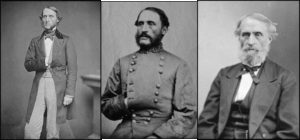Thomas Lanier Clingman Bio-Sketch
QUICK FACTS (TLC)
Name: Thomas Lanier Clingman
Rank: Brigadier General
Education: University of North Carolina
Birth Date: July 27, 1812
Birth Place: Huntsville, NC
Death Date: November 3, 1897
Death Place: Morganton, NC
Thomas Lanier Clingman, born in Huntsville, NC on July 27, 1812, was the son of Jacob and Jane Clingman. He received his education from Iredell County public schools and private tutoring before enrolling at the University of North Carolina. He graduated from the University in 1832 and began to study law. Clingman finished his studies in 1834 and returned to Huntsville. Admitted to the bar, he set up his own practice. Thomas became a member of the N. C. House in 1835 before moving to Asheville in 1836. After serving in the N. C. Senate, he won election in 1843 to the U. S. House of Representatives. He lost re-election in 1845 but in 1847 returned to the U. S. House. Winning subsequent elections enabled him to serve continuously until May 7, 1858 when he replaced Senator Asa Biggs, who resigned. Winning this seat a second time, led to his expulsion due to his support of the Confederacy.
Clingman campaigned for the development of western North Carolina and performed geological studies of the area. Clingman got into a long dispute with Elijah Mitchell over what the tallest peak in the Black Mountain Range was. In 1857, Mitchell died in an accident while attempting to prove that his peak was taller than Clingman’s. In 1880, the U. S. Geological Department proved that Mount Mitchell was taller than Clingman’s Dome.
At the onset of the Civil War, Thomas Clingman commanded the 25th N. C. Infantry in the Peninsula Campaign. He received a promotion to brigadier general in May of 1862. He served with the Army of Northern Virginia until August when he received orders to North Carolina to help in the defense of the state.
Clingman led his brigade in actions around Goldsboro. He, also, led them in an unsuccessful attempt to re-take New Bern, NC under George E. Pickett in 1864. May 16, 1864 saw Clingman and his brigade at Drewry’s Bluff under P. G. T. Beauregard in defense of Richmond. He fought again with the Army of Northern Virginia at Cold Harbor on May 31, 1864 where he received slight wounds in the head. In a battle for the Petersburg and Weldon Railroad, Clingman received a severe wound to the leg and had to return to North Carolina to recover. He rejoined his brigade in April 1865 which was under the command of Joseph E. Johnston. General Clingman ended his part in the war with the surrender of General Johnston on April 26, 1865 to Gen. William T. Sherman.
Upon the end of hostilities, Thomas L. Clingman returned to Asheville and the practice of law. In 1875, he served on the Democratic National Convention. He never ran for elected office again. Thomas Clingman never married. He died in Morganton, NC on November 3, 1897. His body rests in the Riverside Cemetery in Asheville, NC.

